The first was a Black Angku. Angku actually means red (ang) tortoise (ku) as this cake is red in color and shaped like a tortoise. They are usually filled with a sweet paste of greenbean or peanuts. The Black Angku though, is sweet and savory at the same time as the skin is sweet while the fillings, which is a mixture of minced meat and radish, is savory. The black is not artificial coloring but comes from Choh Yip (Rami leaves), a kind of herb, used widely in Hakka snacks.
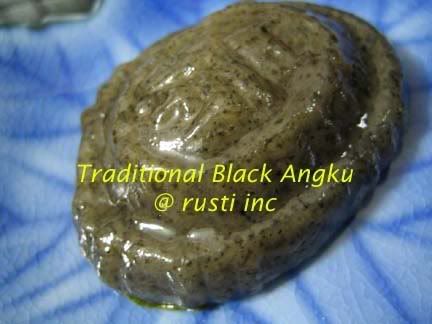
It was not easy for me to buy the fresh Choh Yip and it took me five trips to Johor Bahru before I finally found the dried leaves in a bakery mart there.
The dried leaves need to be reconstituted in water and boiled, before being blended into a paste to be added to the skin.
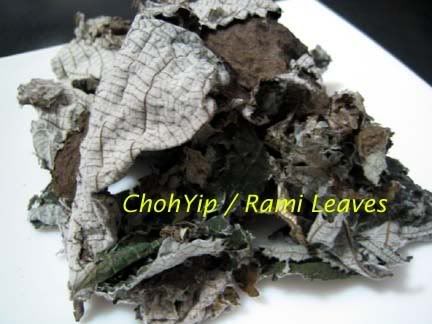
Another traditional cake I made was the Fa Gao or Huat Kueh as it is popularly known. ‘Huat’ means To Prosper in the Hokkien dialect. The Huat Kueh is an all-important cake taking centrestage in most of the Chinese festivals or religious rites at it is believed that by eating the Kueh, it will bring the person lots of money-luck through Prosperity (Huat).
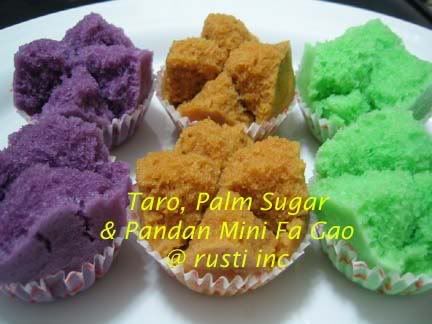
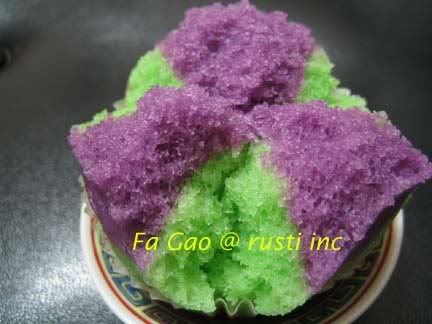
From same basic recipe, I make three different flavors of the kueh. The brown ones are flavored with Palm Sugar. The purple, with Taro Paste and the green, with Pandan Paste. I was a too heavy-handed with the paste and the steamed cakes look like a bright piece of artwork!
Finally, using the balanced of the minced meat & radish fillings from the Black Angku, I churned out a batch of Bowl Cakes or Wa Kueh. A batter made from rice flour & tapioca flour is cooked till thickened and mixed with a portion of the minced meat before being steamed in rice bowls. Midway, they are topped with more minced meat to complete the steaming process.
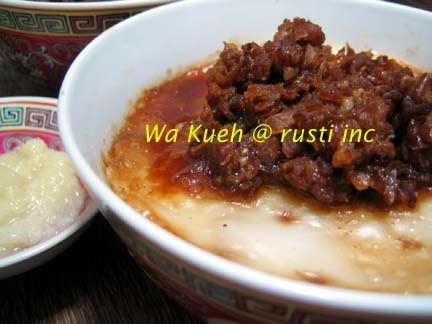
Soft and silky smooth in texture, these cakes are really delicious when served with a dollop of vingared garlic puree.
Wa Kueh
Ingredients for the Kueh:
2-1/2 Chinese ricebowls of rice flour
4 tbsp tapioca starch
6 Chinese ricebowls of water
1/2 - 1 tsp salt
1) Add the salt to the two flours. Mix with 3 bowls of water till free of lumps.
2) Bring the balance 3 bowls of water to the boil. Add in the rice flour mixture, stirring all the time to prevent lumps.
3) Cook till you get a very soft paste.
4) Add 1/3 of the cooked toppings and mix well.
5) Steam in pre-heated bowls over high heat for 15 minutes.
6) Top with the balance toppings and steam for a further 10 minutes.
7) Serve warm or at room temperature.
Toppings:
200gm minced pork
200gm preserved radish (Chai Poh), soaked to remove excess salt, drain well
Sauce:
1 tsp sugar
2 tsp dark soya sauce
1 to 1-1/2 tsp pepper
2 tbsp Taiwanese Aged Soy Paste
1 tbsp Chinese Wine.
3/4 bowl water
1 clove garlic, minced
1) Marinate pork for 1 hour with 1 tsp sugar, 2 tsp soy sauce 1 tsp sesame oil.
2) Heat some oil, saute the radish till fragrant. Dish up and set aside.
3) Heat some oil, saute the garlics till fragrant and add the minced pork. Stir fry till they change color and add the pre-fried radish.
4) Add the seasoning ingredients and drizzle in the wine.
5) Fry for 2-3 minutes and add the water, simmer for a while till you are left with about 1/2 a bowl of sauce.
Vinegared Garlic
Grind 2-3 garlics till very fine and mix with 1/2 tbsp of white vinegar.
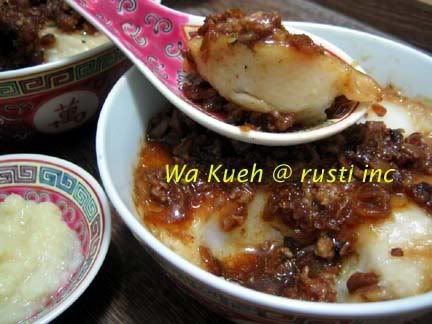
Note:
Add the sauce ingredients gradually and taste as you go along as different brands of chai poh has different levels of saltiness.
11 comments:
I'm the first time visit your blog but I very admire your foods , it's look so good , Please ! can you share the Fa Gao cake receipe ! thank you so much !
Michelle
Hi Michelle
It is very simple.
250gm self-raising flour (sifted)
150gm brown sugar (original recipe uses 200gm)
250ml coconut milk
Just mix everything together and steam in paper cases that have been placed into aluminium tart moulds. Steam over high heat for 15mins.
For colored versions, use plain sugar and add the food paste of your choice.
For palm sugar version, melt chopped palm sugar in 20 ml water over very gentle heat and add to the coconut milk to make 250ml.
If you find the batter too thick, you can add a little bit more water. It doesn't really affect the final outcome. Do strain the mixture to remove all lumps.
Hi Ginny....Your Wa Kueh makes me so hungry. Was crazy over it since I was a kid. However, the ones normally sold in the markets taste so different from those I ate during childhood. Will give your recipe a try once I'm free. :)
Thank you so much for your kindness ! best wish
Michelle
I forgot to ask you if I don't have seft rising flour then what flour I use and how much baking powder to mix ? one again thank you !
Michelle !
Stumbled upon your blog and was very much delighted by your posts. I am full time working and not yet a mom and already I find that I hardly have time to do cooking. By the time I reach home at about 7 plus in the evening, all I manage to do is to grab watever food from outside and stone in front of the tv. How do you manage? Amazing!
Hi Michelle
For every 250g plain flour, you can add between 2-3 tsp of baking powder plus a pinch of salt.
Honeybeanie,
Thanks for visiting my blog. I find baking therapeutic as it relaxes me after a day's work. When I see the fruit of my labor, my stress melts away.
Rusti,
just wanna double confirm your huat kueh only requires the following ingredients ?
250gm self-raising flour (sifted)
150gm brown sugar
250ml coconut milk
So simple ? no egg no oil ?
Thanks!
simonneho@yahoo.com
Rusti,
Can you tell me which bakery mart did you get your Rami leaves from?
Thanks,
Suchee
It can't really have success, I consider like this.
Post a Comment